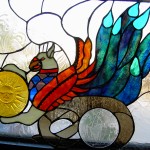Encounter with the Simurgh: A School Experiment
In the course of several centuries, it is only rarely that a large group of individuals may be able to openly organize penetrations into the macrodimensions and explorations of sectors of the Labyrinth ordinarily inaccessible to individuals or smaller groups.
==================
Definitions:
The Simurgh is an immortal bird that nests in the branches of the Tree of Knowledge. . . . The distant king of birds, the Simurgh [according to legend] drops one of his splendid feathers somewhere in the middle of China; on learning of this, the other birds, tired of their present anarchy, decide to seek him. They know that the king’s name means “thirty birds”; they know that his castle lies in the Kaf, the mountain or range of mountains that ring the earth. At the outset, some of the birds lose heart; the nightingale pleads his love for the rose; the parrot his beauty, for which he lives caged; the partridge cannot do without his home in the hills, nor the heron without his marsh, nor the owl without his ruins. But finally, certain of them set out on the perilous venture; they cross seven valleys or seas, the next to last bearing the name of Bewilderment, the last the name Annihilation. Many of the pilgrims desert; the journey takes its toll among the rest. Thirty, made pure by their sufferings, reach the great peak of the Simurgh. At last they behold him; they realize that they are the Simurgh, and that the Simurgh is each of them and all of them.
–Jorge Luis Borges and Margaritha Guerrero, The Book of Imaginary Beings (204-205)
==============
Persia: The Simurgh
Unlike his tricksteresque counterparts Pazuzu and Imdugud/Anzu in Sumer, the Simurgh is known as a beneficial bird-being. The Simurgh is sometimes compared to a phoenix, but is also described (as with Pazuzu and Imdugud/Anzu) as a lion-bodied creature with wings and a bird’s beak. The touch of the Simurgh, or one of its feathers, could heal a man instantly, and apparently the Simurgh had knowledge of how to prepare a special restorative brew known as houma.
According to Persian myth, the Simurgh lived in the Tree of Knowledge, again tying it to the myth of the Anzu, which made its nest in the Huluppu tree. According to the Occultopedia, “When the Simurgh took flight, it was said, its powerful ascent shook the tree’s branches so violently that the seeds [from every plant that has ever existed] were scattered throughout the world, bringing a wealth of valuable plants to mankind. Later, according to myth, the Simurgh nested in seclusion on the sacred Persian mountain of Alburz, far beyond the climbing abilities of any man.” This ties the Simurgh to creation myth, similar to the story of Melek Ta’us breaking apart the cosmic egg to create the world — and to the Watchers’ eventual banishment to remote regions of the desert (or the sky) after their contact with mankind went awry.
================
“Si-“, the first element in the name, has been connected in folk etymology to Modern Persian si “thirty”. Although this prefix is not historically related to the origin of the name simurgh, “thirty” has nonetheless been the basis for legends incorporating that number, for instance, that the simurgh was as large as thirty birds or had thirty colours (siræng).
===============END of Definitions.
So we see above definitions flowing forth about a creature. Something about thirty and fertility and healing … and a being of the first order. Where then is this bird?
Here we enter the world of labyrintine travel. That bird, does not exist in Bolivia, or the mountains above ancient Persia. It is not of this planar existence. Yet, these men and women through our history have described something of a similar core nature over many years and many cultures.
That is because it has objective occurrence in the Labyrinth. When traveling in a bardo space, objective sign posts are encountered.
Now, in this Chapter 12 the school associated with EJ Gold has documented an encounter with this being. The powerful desire is to describe it like something we know… it is like a ____. But, in fact, it is of a different nature.
We will study the school experiment. What did that group see and do?


9 Responses to Chapter 12